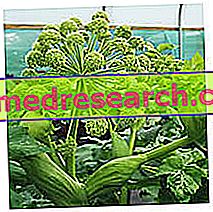Generality
What is Altamura Bread?
The bread of Altamura is an Italian bread, typical of the Pugliese municipality of the same name located in the province of Bari. Produced exclusively with local durum wheat flour, since 2003 the bread of Altamura has been awarded the DOP: Protected Designation of Origin.

The use in the kitchen and the nutritional properties of the bread of Altamura are more or less the same as the other types of bread; below we will go into more detail.
Altamura bread and type of flour
As many will know, the flour that is most suitable for bread making is that of soft wheat (typical of northern Italy), because it gives rise to easily workable and leavenable doughs. That of durum wheat (typical of southern Italy) is instead more tenacious and resistant to cooking in water, which is why it is more suitable for packaging pasta. On the other hand, for the distribution of wheat crops in the area, in the north we mainly use soft wheat flour (also for pasta) and in the south that of durum wheat (also for bread).
In the latter case, to obtain an appreciable result, it is necessary to choose a particularly rich gluten-free flour and to cure impeccably the leavening process, art in which the Altamura bakers are considered true masters.
Description
What does Altamura bread look like?
Altamura bread may have different shapes and sizes (never less than 500 g), although it is traditionally sold as "u skuanete" (accavallato) and "a cappidde del padre de simone" (priest's hat). Instead it is fundamental that it has a thick and crunchy crust (which sounds at the touch), and a light yellow crumb (typical aspect of durum wheat flour, given by its richness in carotenoids) homogeneously alveolar; the maximum humidity must not exceed 33%. This type of bread is famous for its fragrance, fragrant and intense, and for the rich taste that goes well with all the typical ingredients of Mediterranean cuisine.

Nutrition
Nutritional characteristics of Altamura bread
Altamura bread is a product that belongs to the III fundamental group of foods (source of carbohydrates and fiber).
It has a generous caloric intake, which however does not reach 300 kcal / 100 g. Being made from durum wheat flour, the Altamura bread contains more water and a slightly higher specific weight, hence a proportionally lower caloric density compared to soft wheat bread.
Energy is mainly supplied by complex glucides (starch), even if the protein content is not negligible (about 9 g / 100 g). Peptides have a medium biological value and the limiting amino acid is lysine. Fats are present in very low amounts (<1 g per 100 g).
Among the vitamins good concentrations of vit B1 (thiamine), PP (niacin) and carotenoids (provitamin A) can be appreciated. Regarding mineral salts, the amounts of potassium, sodium, iron and phosphorus are discrete. It does not contain cholesterol, while the fibers are present in considerable quantities. It is rich in gluten.
Altamura bread is a food that, like other foods of the same category, must be taken with regard to obesity, type 2 diabetes mellitus and hypertriglyceridemia. It is not suitable for feeding celiac and allergic to wheat proteins. It has no contraindications for lactose intolerance, for vegetarian and vegan philosophy.
The average portion of Altamura bread is 50 g at a time (about 2 slices); the total daily quantity varies according to the composition of the diet.
Ational dey -tyHard wheat bread - with very little yeast
X Problems with video playback? Reload from YouTube Go to Video Page Go to Video Recipes Section Watch the video on youtubeuse
Culinary uses of Altamura bread
Altamura bread lends itself to accompanying products belonging to all 7 fundamental food groups. It is ideal for absorbing the sauces of the meat in a pan and goes well with any recipe based on fish or eggs. It is essential in snacks associated with cold cuts and above all with cheeses such as pecorino (sheep, goat and cow) and mozzarella (also buffalo). Toasted it settles perfectly with legume soups, for example lentils, and with vegetables, both raw (the most classic example is represented by tomatoes) and cooked (in particular stewed pews, tops and turnip leaves, and the onion).
The snack based on Altamura and prickly pears, figs, grapes or wild pears is as old as the bread itself.
Raffermo finds a thousand uses in gratinates, fried foods, panzanella, bread soups, salads etc.
Fresh and still warm, the best way to taste it is with a drizzle of olive oil (robust from the olive trees younger or delicate than the centuries old), local aromatic herbs (oregano, basil, mint) and other spices (garlic, chilli).
Certification
DOP certification: what is it for?
The DOP certification (requested by the Altamura Bread Consortium) aims to protect and pass on the traditional production method that has made Altamura bread one of the most appreciated national foods in Italy as well as abroad. First of all, the disciplinary restricts the choice of flour to local ones, obtained from the re-milling of durum wheats belonging to the varieties: appulo, arcangelo, duilio and simeto (in a minimum quantity of 80%, possibly mixed with other locally produced flours).
The regulation is also restrictive on the choice of water and salt (marine). Moreover, it binds to the use of natural yeasts of the mother type or sourdough, which ensure a long but complete process (without accelerators).
The cooking of Altamura bread must take place in wood-fired food stone ovens, so that the food takes on specific characteristics such as, for example, a crust at least 3 mm thick.
The area of official production of Altamura bread is only Altamura itself, while the geographical area of cultivation of wheat includes: Altamura, Gravina in Puglia, Poggiorsini (Spinazzola and Minervino Murge).



